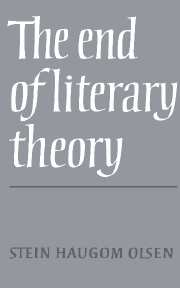Book contents
- Frontmatter
- Contents
- Preface
- Literary aesthetics and literary practice
- Interpretation and intention
- Authorial intention
- Text and meaning
- The ‘meaning’ of a literary work
- Defining a literary work
- What is poetics?
- On unilluminating criticism
- Criticism and appreciation
- Value-judgements in criticism
- Literature, fiction, and reality. A problematic relationship
- Thematic concepts: where philosophy meets literature
- Literary theory and literary aesthetics
- Notes
- Bibliography
- Index
Text and meaning
Published online by Cambridge University Press: 05 November 2011
- Frontmatter
- Contents
- Preface
- Literary aesthetics and literary practice
- Interpretation and intention
- Authorial intention
- Text and meaning
- The ‘meaning’ of a literary work
- Defining a literary work
- What is poetics?
- On unilluminating criticism
- Criticism and appreciation
- Value-judgements in criticism
- Literature, fiction, and reality. A problematic relationship
- Thematic concepts: where philosophy meets literature
- Literary theory and literary aesthetics
- Notes
- Bibliography
- Index
Summary
There is something odd in talking about the ‘meaning’ of a text. Words have a meaning or meanings and so do sentences and utterances and conventional signs like traffic-lights or morse-signals. Single actions have a meaning which may be deduced from their relationship to other actions and ultimately to an end, and larger patterns of rational behaviour can also be said to have meaning, though here it might be more natural to talk about ‘purpose’. A competent speaker of a language can explain the meaning of words and sentences and one is constantly ascribing meaning to other people's actions by identifying their goals and motives. However, a text does not have a meaning (or several meanings) which can be stated or explained. For what is the meaning of, say, Hume's Treatise? One cannot answer such a question with ‘The meaning of Hume's Treatise is …’, filling in the blank with a statement of its meaning. Perhaps it might be said that the meaning of a text is apprehended in interpretation. But not all texts require interpretation. The instruction manual to my Black and Decker drill serves its purpose if I understand each single instruction or each of the utterances making up an instruction. The manual must of course fulfil certain requirements of clarity and coherence, but there is no further ‘meaning’ which must be understood in addition to the meaning of the single utterance.
- Type
- Chapter
- Information
- The End of Literary Theory , pp. 42 - 52Publisher: Cambridge University PressPrint publication year: 1987
- 1
- Cited by



